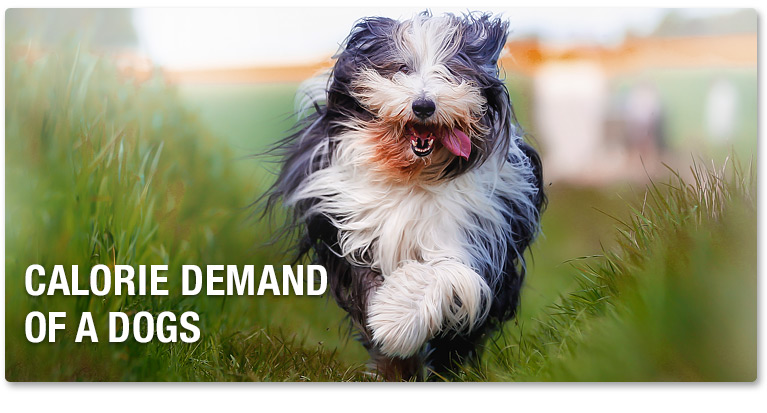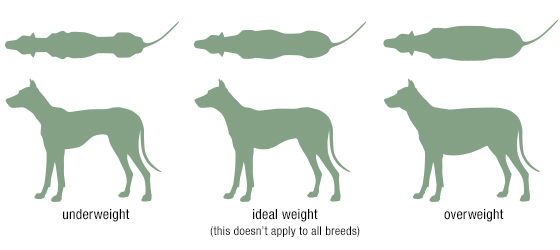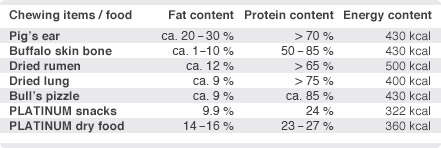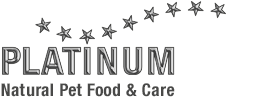
Energy demand of our dogs - Ideal body weight of our pets
Energy demand means the amount of energy that dogs need for its vital functions and physical fitness. This should be covered with the daily food ration. Dogs not only need energy for muscle power, but also for the general basal metabolic rate (for example regulation of body temperature and maintaining of essential functions as breathing and cardiac function). For this reason also a sleeping dog needs energy.
The challenge is to find the right dose or better the optimum quantity. Dogs incorporating too much energy are easily overbalanced, less input of energy leads to loss of weight and signs of deficiency (especially in the growth period). The ideal body weight can only be gained if the feeding amount covers the demand of energy. As such dogs have rather an ideal view than an ideal weight. By increasing the level of dog’s activity the mass of muscle also increases while the amount of fat decrease. As muscles are heavier than fat, the scale would falsely show an increase of (over)weight. For this reason the ideal weight should be determined by view and not by weight. Viewed from above the waist (behind the ribs) and the hold on abdominal line should be visible, also the ribs should be felt with gentle pressure.

The demand of calories differs a lot from dog to dog. Why?
On one hand the level of activity is deciding: active, sportive or working dogs have a higher consumption of energy. On the other hand there are several other aspects requiring a higher amount of food. Young and bubbly dogs need more food than the older and calm ones. Growing dogs need more food in any case, but also stock haired breed as for example Dalmatians need more energy to sustain their body temperature as long haired breeds with thick undercoats (as Newfoundland dogs). Castration, specific illnesses, strong muscles, out-door keeping and pregnancy are also affecting the demand of energy!
Due to various factors the necessary daily amount of energy respective the amount of calories differs a lot. Size and weight are one of the factors. One should consider that a 40 kg dog not just has the 8 time demand of a 5 kg dog – in average they just need less than 5 times more food! In comparison small dogs have a bigger body surface which loses warmth, resp. energy. For this reason small dogs need proportionally (not utterly) more energy than the big ones. Comparing a 5 kg to a 40 kg dog – the small one would need 320 kcal = 90 g Adult Chicken per day the big one 1500 kcal = 430 g.
So only for the kind of breed, age, sex, size, metabolism and level of activity the demand of energy differs a lot. For this reason the feeding advice can just be a rough guideline which reflects the energy demand of the average dog. Variations to more or less food are normal and the goal is to detect the right feeding amount for the own dog. By reference to the feeding list, it is possible to find out the recommended value. Generally the ideal weight and not the current weight is the measure of all things. Adapt the feeding amount in small steps and watch the change in weight during 1 to 2 weeks.
If the dog ingests more energy than needed, the redundant energy will be transformed into body fat and leads to overweight. Overweight dogs shouldn’t be put on diet in reducing drastically the food amount. This could lead to a lack of nourishment in proteins, vitamins and minerals. We recommend a reduction of maximum one third and your dog should lose 1 to 2 % of its body weight in one week - not more - this would be too much stress for the organism. As a consequence a dog of 40 kg would lose around 400 to 800 g a week.
Overweight dogs have – as humans – a high risk of secondary diseases. This could be problems with the cardiovascular system and the respiratory. There is also a higher risk if it is necessary to put the dog into anaesthesia. Besides a high body weight leads to a reduction of activity with the result of further overweight – a vicious circle. For this reason “in between snacks” and chewing products should be minimize and subtracted from the daily feeding amount. For a 5 kg dog 20 g of snacks are already one fifth of the daily feeding amount.
How many calories (per 100 g) have usual chewing products and PLATINUM products?

Advancing age mostly leads to a lower demand of energy. Dog’s activity decreases and is sometimes additionally restricted by diseases. The metabolism of old dogs gets also slower. Therefore watch your older dog carefully and adapt the feeding amount if necessary. Especially dogs suffering from arthrosis shouldn’t be overweight.
As opposed to this pregnant and especially lactating bitches need much more energy. It is absolutely important to raise the input of energy to avoid the losing of weight.














































